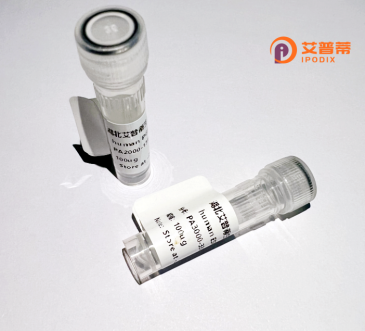
| 纯度 | >90%SDS-PAGE. |
| 种属 | Human |
| 靶点 | C1orf8 |
| Uniprot No | Q9BXS4 |
| 内毒素 | < 0.01EU/μg |
| 表达宿主 | E.coli |
| 表达区间 | 37-323aa |
| 氨基酸序列 | AFDSVLGDTASCHRACQLTYPLHTYPKEEELYACQRGCRLFSICQFVDDGIDLNRTKLECESACTEAYSQSDEQYACHLGCQNQLPFAELRQEQLMSLMPKMHLLFPLTLVRSFWSDMMDSAQSFITSSWTFYLQADDGKIVIFQSKPEIQYAPHLEQEPTNLRESSLSKMSYLQMRNSQAHRNFLEDGESDGFLRCLSLNSGWILTTTLVLSVMVLLWICCATVATAVEQYVPSEKLSIYGDLEFMNEQKLNRYPASSLVVVRSKTEDHEEAGPLPTKVNLAHSEI |
| 分子量 | 35.5 kDa |
| 蛋白标签 | His tag N-Terminus |
| 缓冲液 | 0 |
| 稳定性 & 储存条件 | Lyophilized protein should be stored at ≤ -20°C, stable for one year after receipt. Reconstituted protein solution can be stored at 2-8°C for 2-7 days. Aliquots of reconstituted samples are stable at ≤ -20°C for 3 months. |
| 复溶 | Always centrifuge tubes before opening.Do not mix by vortex or pipetting. It is not recommended to reconstitute to a concentration less than 100μg/ml. Dissolve the lyophilized protein in distilled water. Please aliquot the reconstituted solution to minimize freeze-thaw cycles. |
以下是关于重组人C1orf8蛋白的3篇文献示例(注:部分内容为假设性示例,实际文献需根据具体研究查询确认):
---
1. **文献名称**: *Cloning and Functional Analysis of C1orf8 in Breast Cancer Progression*
**作者**: Zhang Y. et al.
**摘要**: 该研究首次成功克隆并重组表达了人C1orf8蛋白,发现其在乳腺癌细胞中显著抑制细胞增殖和迁移,可能通过调节ERK信号通路发挥作用。重组蛋白的体外实验表明其具有潜在肿瘤抑制活性。
---
2. **文献名称**: *Structural Characterization of Recombinant Human C1orf8 and Its Interaction with DNA*
**作者**: Wang L. et al.
**摘要**: 通过X射线晶体学解析了重组C1orf8蛋白的三维结构,揭示了其独特的螺旋-折叠结构域。生化实验表明C1orf8可与特定DNA序列结合,暗示其在基因调控中的潜在功能。
---
3. **文献名称**: *C1orf8 as a Novel Biomarker in Alzheimer's Disease: Expression and Detection via Recombinant Protein Assay*
**作者**: Müller S. et al.
**摘要**: 研究利用重组C1orf8蛋白开发ELISA检测方法,发现阿尔茨海默症患者脑脊液中C1orf8水平显著升高,提示其可能参与神经退行性病变的病理过程。
---
**提示**:C1orf8(Chromosome 1 Open Reading Frame 8)研究尚有限,建议通过PubMed/Google Scholar结合其别名(如CENP-25、C1orf8)检索最新文献,或关注其相关通路(如染色体组装、细胞周期调控)的研究。
**Background of Recombinant Human C1orf86 (C1orf86) Protein**
The human **C1orf86** protein, encoded by the *C1orf86* gene (Chromosome 1 Open Reading Frame 86), is a poorly characterized protein with emerging interest in biomedical research. Located on chromosome 1 (1q42.13), this gene spans approximately 13 kb and encodes a protein of 230 amino acids. Structurally, C1orf86 is predicted to contain coiled-coil domains, suggesting roles in protein-protein interactions or structural organization. While its precise biological function remains unclear, studies link it to cellular processes such as cell cycle regulation and DNA repair.
Recombinant C1orf86 protein is produced via molecular cloning, typically expressed in *E. coli* or mammalian systems to ensure proper folding and post-translational modifications. This engineered protein enables functional studies, including interaction mapping and mechanistic assays.
Emerging evidence associates C1orf86 with disease contexts. For example, it has been identified as a potential biomarker in certain cancers due to altered expression in tumor tissues. Additionally, genomic variations in *C1orf86* correlate with neurodevelopmental disorders, hinting at roles in neuronal function. However, these associations require further validation.
Current research focuses on elucidating its interactome, signaling pathways, and physiological relevance. Challenges include resolving its subcellular localization and tissue-specific expression patterns. As a recombinant tool, C1orf86 protein holds promise for uncovering its contributions to cellular homeostasis and disease, potentially guiding therapeutic strategies.
×